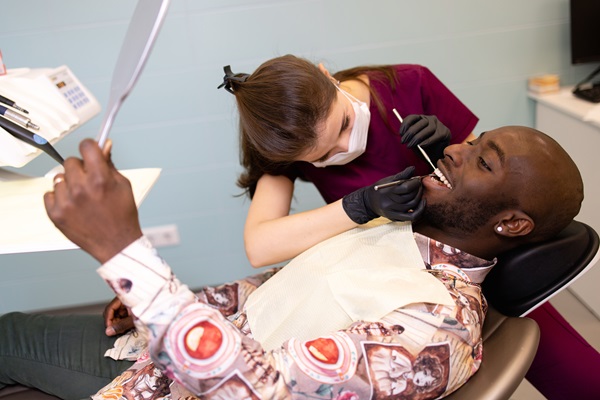A Brief Overview of Cosmetic Contouring

Cosmetic contouring, also known as tooth reshaping, is a noninvasive dental procedure designed to improve the appearance of teeth by altering their size, shape, or surface. This quick and effective treatment is ideal for patients looking to enhance their smile without undergoing extensive dental work. It is popular for addressing minor imperfections and achieving a more balanced appearance.
Understanding cosmetic contouring
Cosmetic contouring is a procedure that involves gently removing small amounts of enamel, the outermost layer of the tooth, to reshape or smooth uneven edges, chips, or minor overlaps. Since the treatment focuses solely on the enamel, it does not require anesthesia, making it a convenient and painless option for improving a smile.
In some cases, the dentist pairs cosmetic contouring with dental bonding, a procedure that uses tooth-colored resin to further refine the tooth's shape or fill in small gaps. Together, these treatments can significantly enhance the overall appearance of teeth while maintaining a natural look.
The ideal candidate for cosmetic contouring
Cosmetic contouring is effective for those with minor imperfections, such as small chips, slightly uneven teeth, or minimal overlaps. Patients with healthy teeth and sufficient enamel are ideal candidates, as the procedure requires removing a small amount of the enamel layer. It is important to note that cosmetic contouring is unsuitable for addressing major dental issues, such as severe misalignment, decay, or extensive damage. A consultation with a general dentist can help determine whether cosmetic contouring is the right choice for achieving a patient's desired results.
Benefits of cosmetic contouring
Should the general dentist approve cosmetic contouring, they open patients to various benefits. These include:
- Improved aesthetics. By creating smoother, more uniform surfaces, cosmetic contouring can address minor imperfections, such as uneven tooth length, rough edges, or slightly overlapping teeth.
- Noninvasive. Unlike more extensive dental procedures, cosmetic contouring does not require drilling, anesthesia, or significant recovery times.
- Quick and convenient. After the initial consultation, patients can receive an improved smile in one appointment, making it ideal for those with busy schedules.
- Enhances oral health. Plaque can build and hide on rough edges, making it difficult for toothbrushes to eliminate all of it; smoothing them down removes this threat.
The process of cosmetic contouring
The process of cosmetic contouring is straightforward and occurs in four steps:
- Step one. Using a fine dental instrument, the dentist marks areas that need to be reshaped on each tooth.
- Step two. Using a special tool or laser, the dentist gently removes small amounts of the enamel, smoothing rough edges, correcting unevenness, or altering its shape.
- Step three. After reshaping, the dentist polishes the tooth surface to ensure a smooth, natural appearance that blends seamlessly with the rest of the teeth.
- Step four. The dentist reviews the results with the patient, ensuring changes are as they desire.
With these precise steps, patients can receive their dream smile for many years to come.
Call us for more information
With its noninvasive nature and immediate results, cosmetic contouring is an excellent option for individuals looking to make small yet impactful changes to their smile. Consulting with a skilled general or cosmetic dentist ensures a tailored approach to achieving ideal outcomes, resulting in a radiant smile. Contact Riverfront Dental Associates for more information or to schedule an appointment.
Request an appointment here: https://www.riverfrontdentalassociates.com or call Riverfront Dental Associates at (423) 303-7869 for an appointment in our Chattanooga office.
Check out what others are saying about our services on Yelp: Read our Yelp reviews.
Related Posts
Gum disease develops in stages, and early action protects oral health and overall wellness. This common condition starts when plaque, a sticky film of bacteria, accumulates along the gumline. When not removed, plaque hardens into tartar, which irritates the tissues and triggers inflammation. Without treatment, inflammation can spread into deeper structures, damaging the ligaments and…
Clear aligners are a great orthodontic option that many general dentists are now offering. They are popular due to their flexibility, convenience, and ease; however, because they are still considered relatively new to dentistry, there are still a lot of questions regarding how they work and what the treatment process entails. Read on to learn…
A restorative dentist focuses on diagnosing and treating dental problems that affect the function and appearance of the teeth. While general dentistry emphasizes prevention and maintenance, a restorative dentist provides solutions for damaged, decayed, or missing teeth. These services are essential for patients seeking to regain comfort, oral function, and confidence in their smiles. Our…
When it comes to general dentistry, there are a lot of different materials used. Metal, in particular, has been used for a long time, which makes it a reliable material when it comes to certain procedures. Of course, there are many other materials that can be used and that are frequently selected, but metal is…
